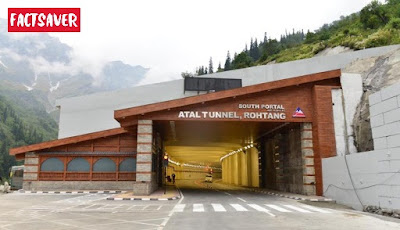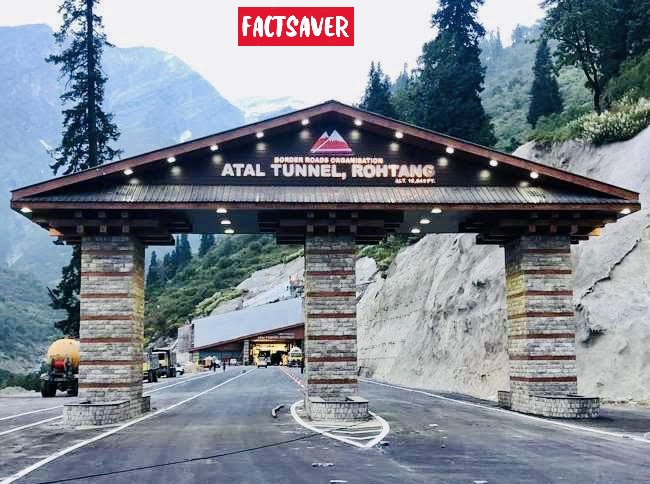Atal Tunnel (also known as Rohtang Tunnel) is a highway tunnel built under the Rohtang Pass in the eastern Pir Panjal range of the Himalayas on the Leh-Manali Highway in Himachal Pradesh, India.
At a length of 9.02 km, it is the longest tunnel above 10,000 feet (3,048 m) in the world and is named after former Prime Minister of India, Atal Bihari Vajpayee.
The tunnel reduces the travel time and overall distance between Manali and Keylong on the way to Leh.
The tunnel is at an elevation of 3,100 metres (10,171 ft) whereas the Rohtang Pass is at an elevation of 3,978 metres (13,051 ft.)
The cost of the entire project is ₹3,200 crore (US$438 million)
The project was announced by the then Prime Minister Atal Bihari Vajpayee on 3 June 2000. The work was entrusted to BRO on 6 May 2002.
The foundation stone of the project was laid on 28 June 2010 by Sonia Gandhi in her capacity as the Chairperson of National Advisory Council.
In September 2020 100% of project completed.
In October 2020, the tunnel was inaugurated by the Prime Minister, Narendra Modi on 3 October 2020, in the presence of Minister of Defence, Rajnath Singh and Chief Minister of Himachal Pradesh, Jai Ram Thakur and Minister of State for Finance, Anurag Thakur.
The tunnel is intended to create an all-weather route to Leh and Lahaul and Spiti valleys in Himachal Pradesh.
The man who made the ambitious project a reality happens to be a Malayali — Border Roads Organisation Chief Engineer KP Purushothaman from Echoor in Kannur.
Length: 9.02 km (5.6 mi)
Shape (cross-section) of Tunnel: Horseshoe
Shape (cross-section) of Tunnel: Horseshoe
Finished width: 10.00 m (32.8 ft) at road level. (8m pavement and 1m footpath on both sides)
General altitude of the tunnel: 3,000–3,100 m or 9,840–10,170 ft
Designated vehicular speed: 80 km/h (50 mph)
Geology of tunnelling media: Uniformly dipping alternate sequence of quartzites, quartzitic schists, quartz-diolite-schist with thin bands.
Tunnel boring machines were not used because of the inability to see inside the mountain, instead blasting and digging used to build the tunnel.
Temperature variation in the area: 25–30 °C (77–86 °F) during May–June, −30 to −20 °C (−22 to −4 °F) during Dec–Jan.
Overburden: Maximum 1,900 metres (6,230 ft), average more than 600 m (1,970 ft)
Construction technique: Drill & Blast with NATM
Support system: Fibre-reinforced concrete (100–300mm or 0–10 inch thick) combined with rock bolt (26.50mm dia, 5,000–9,000mm or 200–350 inch long) has been used as the principal support system. In areas of poor rock condition, yieldable steel ribs (ISMB 150/ISMB 300) have been used.
Tunnel ventilation: Semi-transverse system of ventilation.
A 2.25 m high and 3.6 m wide emergency tunnel is integrated in the tunnel cross-section beneath the main carriageway.
The tunnel named after former prime minister Atal Bihari Vajpayee has got many specialities. About 12,252 metric tonnes of steel, 1,69,426 metric tonnes of cement and 1,01,336 metric tonnes of concrete were used to construct it. About 5,05,264 metric tonnes of rock and soil were excavated during the tunnel’s construction.
There is a telephone facility every 150 metres, a fire hydrant every 60 metres, an emergency exit every 500 meters, air quality monitoring system every kilometre, and an automatic detection system with CCTV cameras every 250 metres to detect and broadcast events.
The 9.02 km (5.6 mi) long tunnel is the world's longest tunnel at an altitude above 3,000 m(10,000 ft).
The nearest in comparison to the Rohtang Tunnel is the Anzob Tunnel in Tajikistan (length 5 km (3.1 mi), altitude 3,372 metres (11,063 ft)), Salang Tunnel in the Hindu Kush mountains in Afghanistan (length 2.6 km, altitude 3,400m) and the Eisenhower–Johnson Memorial Tunnel in United States (length 2.73 km (1.7 mi), altitude 3,401 m (11,158 ft)).











0 Comments